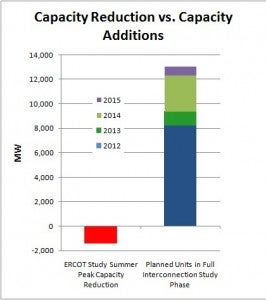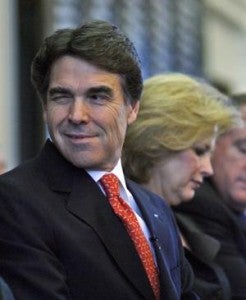Déjà Vu All Over Again
Listen carefully these days and you might think it was last year, 2009, or even 2006. Just a year ago, Governor Perry lambasted the EPA’s decision that Texas’ air permitting program was illegal and amounted to special treatment for a single state when all other states are in compliance with the law. In a statement at the time Perry claimed “The EPA’s irresponsible and heavy-handed action …. threatens thousands of Texas jobs, families, businesses and communities throughout our state.” Perry went on to claim that “it will also likely curtail energy supplies and increase gasoline prices nationwide.” Last month the EPA announced that every former Texas permit holder is now successfully working with the agency on their new permits. No more claims of job losses or gasoline shortages, just companies working with regulators to abide by the law and protect the health of Texans.
In 2006, TXU (now Luminant), the largest power plant owner in Texas, announced that they needed to build 11 coal plants to make sure there weren’t any rolling blackouts in the next few years. A serious PR campaign ensued with TXU and Governor Perry trying to fast track the coal plants, but as it turned out, they weren’t needed, and that’s part of the reason TXU is now known as the Energy Future Holdings (EFH), the parent company of Luminant. In fact, the coal plants that Luminant did build, Oak Grove and Sandow, were a big part of the reason Texas experienced the blackouts in February – supposedly reliable, 24-hour coal plants tripped offline when it got too cold.
Repetitive Stress Injury
Raising the threat of job losses, blackouts or other specters has become so common for Perry and industry that it probably amounts to muscle memory at this point. It reached a new level this week, however, when Luminant decided that it would lay people off in order to make a statement. While Luminant may not like the Cross-State Air Pollution Rule (CSAPR), it’s essentially a “Good Neighbor” rule and none of the clean air protections in the rule require any power plants to shut down. Companies like Luminant make the decision — either invest in common retrofits like scrubbers to clean up pollution or close down old and poorly controlled plants and replace them with cleaner more efficient generation.
Numerous companies, such as Houston based Dynegy, Exelon, PPL Generation and NRG Energy, have publicly announced that they are well-prepared to meet the updated clean air protections. As Dynegy’s CEO Robert Flexon points out: “Any efforts to delay or derail CSAPR would undermine the reasonable, investment-based expectations of Dynegy. In our case, CSAPR allows competitive markets to confer deserved economic returns on our investments in clean energy technology.” In his Houston Chronicle business column today, Loren Steffy muses: “Funny how much difference good financing and a little planning can make. After all, power generators knew that, sooner or later, stricter air standards were coming.”
Scare Tactics
This also means that claims of rolling blackouts are vastly overstated. While a study released by Electric Reliability Council of Texas (ERCOT) has received a lot of coverage, the headlines have focused far more on flash than substance. In fact, ERCOT admits that Texas has had 6 years to prepare for this rule, beginning with the passage of the Clean Air Interstate Rule in 2006, which included Texas. What’s even more troubling is that ERCOT seems to assume that neither the grid operator, nor any of the power companies, intends to learn from the lessons of this past year in terms of better preparations for extreme weather. ERCOT assumes that this time next year our power plants will again be unprepared for long periods of hot weather. In Texas.
In fact, a close reading of the ERCOT study actually rebuts the most popular arguments of state officials and industry that Texas had no warning that this rule was coming:
“The rule is a replacement for the Clean Air Interstate Rule (CAIR), which was implemented in 2005. The CAIR was remanded to the EPA by the United States Court of Appeals for the District of Columbia Circuit in 2008. In the CAIR program, Texas was regulated for particulate matter emissions (annual NOX and SO2 emissions).”
In their presentation to the Texas Public Utilities Commission (PUC), ERCOT directly contradicted the claims of industry and officials protesting this rule. At the center of this argument is the idea that EPA’s modeling, which shows increased prices for low sulfur coal, is incorrect. ERCOT’s conclusions seem to support the EPA’s modeling, though, stating that the rule “will have impacts on national fuel markets, increasing demand for natural gas and low sulfur sub-bituminous coal.”
A Texas Tradition: Politicizing ERCOT
It would be much easier to take ERCOT’s study seriously if the organization hadn’t become so politicized over the last 5 years. In 2006 TXU (now Luminant) seized on a flawed ERCOT analysis to justify the need to build 11 new coal plants to boost reserve margins in 2009/2010. The plan stalled and 2010 reserve margins proved much higher than ERCOT’s original projections. Since then, using ERCOT studies to meet the needs of the moment has become a science, whether it serves the needs of someone running for President on a platform of clean air bashing or one of the companies running their committees.
 In the latest example, the desired outcome of ERCOT’s latest study was made clear by a number of public statements from Texas PUC Chairwoman Nelson prior to the study’s release, including her August 4th letter to the EPA and her statement in late August: “I have no doubt in my mind that this rule will result in reliability issues and rolling outages in Texas.” It’s a little like the boy who cried wolf, but this time businesses are laying off workers because their management team failed to plan accordingly to abide by the law. It’s an especially hard claim to swallow given that ERCOT’s own planning documents show over 12,000 MW of resources are expected to come online within the next few years.
In the latest example, the desired outcome of ERCOT’s latest study was made clear by a number of public statements from Texas PUC Chairwoman Nelson prior to the study’s release, including her August 4th letter to the EPA and her statement in late August: “I have no doubt in my mind that this rule will result in reliability issues and rolling outages in Texas.” It’s a little like the boy who cried wolf, but this time businesses are laying off workers because their management team failed to plan accordingly to abide by the law. It’s an especially hard claim to swallow given that ERCOT’s own planning documents show over 12,000 MW of resources are expected to come online within the next few years.
Gambling Away Jobs
The truth is that Luminant, just like Dynegy, Exelon, NRG, the Lower Colorado River Authority, Austin Energy and San Antonio’s CPS made a choice in 2005. As other companies planned for compliance, Luminant chose to fight it, gambling with their shareholders’ money and their employees’ jobs. Think of this: In 2005, there were 32 other power plants in the nation that emitted more sulfur dioxide (SO2) than Luminant’s Martin Lake coal plant. By 2010 there were only three. At the time, Luminant probably thought that by not investing in retrofits like scrubbers to clean up pollution, they could get ahead of the competition. Ironically, what they have found out instead is that they are actually behind the competition, and now their employees may suffer for poor decisions made by management.











One Comment
Great paper.